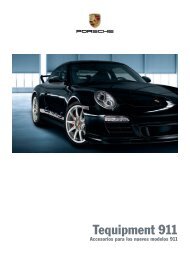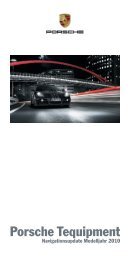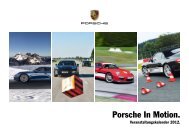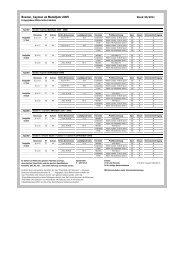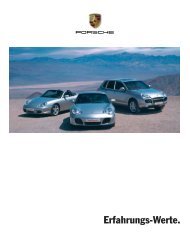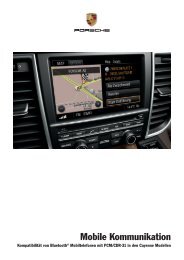Create successful ePaper yourself
Turn your PDF publications into a flip-book with our unique Google optimized e-Paper software.
How Emission Control Works<br />
When an automobile engine is running, it uses energy<br />
generated through the combustion of a mixture<br />
of air and fuel. Depending on whether a car is<br />
driven fast or slowly or whether the engine is cold<br />
or hot, some of the fuel (hydrocarbons) may not<br />
be burned completely, but may be discharged into<br />
the engine crankcase or exhaust system. Additonal<br />
hydrocarbons may enter the atmosphere<br />
through evaporation of fuel from the fuel tank.<br />
These hydrocarbons (HC), when released into the<br />
air, contribute to undesirable pollution.<br />
In addition, carbon monoxide (CO) and oxides of<br />
nitrogen (NOx) contribute to engine emissions.<br />
They, too, are formed during the combustion process<br />
and discharged into the exhaust system.<br />
To reduce these pollutants, your Porsche is<br />
equipped with a precisely calibrated fuel injection<br />
system to assure a finely balanced air/fuel mixture<br />
under all operating conditions.<br />
Oxygen sensor<br />
The oxygen sensor, installed in the exhaust pipe<br />
continuously senses the oxygen content of the<br />
exhaust and signals the information to an electronic<br />
control unit. The control unit corrects the air/<br />
fuel ratio, so the engine always receives an accurately<br />
metered air/fuel mixture.<br />
Crankcase ventilation<br />
Through crankcase ventilation, undesirable emissions<br />
from the engine crankcase are not permitted<br />
to reach the outside atmosphere. These emissions<br />
are recirculated from the crankcase to the<br />
air intake system. From here the emissions mix<br />
with the intake air and are later burned in the engine.<br />
Catalytic converters<br />
The catalytic converters are efficient “clean-up”<br />
devices built into the exhaust system of the vehicle.<br />
The catalytic converters burn the undesirable<br />
pollutants in the exhaust gas before it is released<br />
into the atmosphere.<br />
The exclusive use of unleaded fuel is critically<br />
important for the life of the catalytic converters.<br />
Therefore, only unleaded fuel must<br />
be used.<br />
The catalytic converters will be damaged by:<br />
– push or tow starting the vehicle<br />
– misfiring of the engine<br />
– turning off the ignition while the vehicle is moving<br />
or<br />
– driving until the fuel tank is completely empty<br />
– by other unusual operating conditions.<br />
f Do not continue to operate your vehicle under<br />
these conditions, since raw fuel might reach<br />
the catalytic converters. This could result in<br />
overheating of the converters. Federal law prohibits<br />
use of leaded fuel in this car.<br />
Maintenance, Car Care 199




